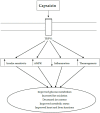Capsaicin in Metabolic Syndrome
- PMID: 29772784
- PMCID: PMC5986509
- DOI: 10.3390/nu10050630
Capsaicin in Metabolic Syndrome
Abstract
Capsaicin, the major active constituent of chilli, is an agonist on transient receptor potential vanilloid channel 1 (TRPV1). TRPV1 is present on many metabolically active tissues, making it a potentially relevant target for metabolic interventions. Insulin resistance and obesity, being the major components of metabolic syndrome, increase the risk for the development of cardiovascular disease, type 2 diabetes, and non-alcoholic fatty liver disease. In vitro and pre-clinical studies have established the effectiveness of low-dose dietary capsaicin in attenuating metabolic disorders. These responses of capsaicin are mediated through activation of TRPV1, which can then modulate processes such as browning of adipocytes, and activation of metabolic modulators including AMP-activated protein kinase (AMPK), peroxisome proliferator-activated receptor α (PPARα), uncoupling protein 1 (UCP1), and glucagon-like peptide 1 (GLP-1). Modulation of these pathways by capsaicin can increase fat oxidation, improve insulin sensitivity, decrease body fat, and improve heart and liver function. Identifying suitable ways of administering capsaicin at an effective dose would warrant its clinical use through the activation of TRPV1. This review highlights the mechanistic options to improve metabolic syndrome with capsaicin.
Keywords: TRPV1; capsaicin; diabetes; insulin resistance; metabolic syndrome; non-alcoholic fatty liver disease; obesity; transient receptor potential vanilloid channel 1.
Conflict of interest statement
The authors declare no conflicts of interest.
Figures
References
-
- Thresh J.C. Capsaicin, the active principle of capsicum fruits. Pharm. J. Trans. 1876;7:259–260.
-
- Nelson E.K. The constitution of capsaicin, the pungent principle of capsicum. J. Am. Chem. Soc. 1919;41:1115–1121. doi: 10.1021/ja02228a011. - DOI
-
- Späth E., Darling S.F. Synthese des capsaicins. Eur. J. Inorg. Chem. 1930;63:737–743. doi: 10.1002/cber.19300630331. - DOI
-
- Zahra N., Alim-un-Nisa I.K., Hina S., Javed A., Inam S.M., Malik S.M., Arshad F. Estimation of capsaicin in different chilli varieties using different extraction techniques and HPLC method: A review. Pak. J. Food Sci. 2016;26:54–60.
Publication types
MeSH terms
Substances
LinkOut - more resources
Full Text Sources
Other Literature Sources
Medical
Research Materials



